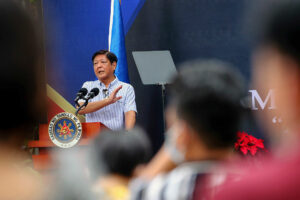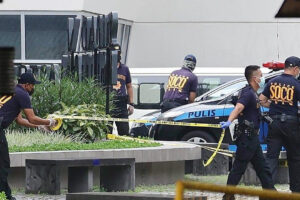Marcos cites progress in ties with China as far as fishing activities go

By Beatriz Marie D. Cruz, Reporter
PRESIDENT Ferdinand R. Marcos, Jr. on Tuesday said the Philippines and China have made progress in coordinating fishing activities in the South China Sea.
“We are making some progress in that regard,” he told reporters on the sidelines of an Agriculture event, adding that the two countries have started coordinating on China’s yearly fishing ban.
He made the remarks after a Chinese Navy vessel reportedly tailed a multi-mission offshore civilian patrol vessel in a Philippine-claimed area of the waterway last week.
Mr. Marcos said the fact that the Chinese vessel did not block and only tailed the Philippine patrol vessel is an improvement in itself.
“These things do not come very quickly,” he said. “But we are slowly making progress because the key to that is the improved communication between the Philippine government and Chinese government.”
Mr. Marcos said he’s “continuing to talk” to the Chinese government and President Xi Jinping “in every way” to avoid a clash between Filipino fishermen and Chinese authorities in the area.
At the weekend, an official from the Bureau of Fisheries and Aquatic Resources (BFAR) said Filipino fishermen could increase their catch if there were no aggressive Chinese activities.
BFAR spokesman Naz Briguera told a media forum the agency did not want to downplay the significance of the South China Sea in the country’s fish production and food security. Philippine-claimed areas contributed 6% to fishery output in 2022, he said.
Meanwhile, the presidential palace said Mr. Marcos had ordered the Agriculture department and BFAR to come up with studies on the rehabilitation and maintenance of the country’s marine habitats “to address illegal, unreported and unregulated fishing.”
The president issued the order at a June 13 meeting, where he cited the need for the Philippines to comply with international commitments, particularly to the European Union on preventing illegal fishing.
“He also highlighted the importance of addressing the concerns of fishery stakeholders by using a science-based approach in managing marine resources,” the Presidential Communications Office said in a statement.
POLITICAL WEIGHTAlso on Tuesday, Senator Ana Theresia “Risa” N. Hontiveros-Baraquel said her proposal for a United Nations (UN) intervention to stop Chinese harassment of Philippine Coast Guard vessels could influence international norms and policies.
“A UN General Assembly resolution has the potential to hone international norms and influence even national policies of its member-nations, whether it’s the Philippines, China, or others,” she told an online news briefing.
She said a UN resolution could guide other UN specialized agencies and regional organizations like the Association of Southeast Asian Nations (ASEAN) on how it approaches the sea dispute.
“Although not legally binding, [the proposed UN resolution] has political weight and serves as an expression of the will and consensus of the international community,” she added.
The senator has filed a resolution urging the Philippine government through the Department of Foreign Affairs (DFA) to sponsor a resolution before the UN General Assembly asking China to stop harassing the Philippine Coast Guard in the disputed waterway.
Beijing’s “blunt refusal to accept its legal fate should have serious consequences,” Ms. Hontiveros said in Filipino.
China claims more than 80% of the South China Sea, which is believed to contain massive oil and gas deposits and through which billions of dollars in trade passes each year.
UN intervention would serve Philippine interests but “could harden the position of China,” Rommel C. Banlaoi, director of the Center for Intelligence and National Security Studies at the Philippine Institute for Peace, Violence and Terrorism Research, said in a Viber message.
The dispute could be resolved peacefully through direct consultations and negotiations, he added.
China has ignored the 2016 ruling by a United Nations-backed arbitration court that voided its claim based on a 1940s map.
The Philippines has been unable to enforce the ruling and has since filed hundreds of protests over what it calls encroachment and harassment by China’s coast guard and its vast fishing fleet.
Last week, civilian vessel BRP Malapascua was shadowed by vessels of the Chinese Coast Guard.
The Philippines sent 262 note verbales to China from 2016 to 2021, the Department of Foreign Affairs (DFA) said in January. It had filed 68 diplomatic protests under the government of Mr. Marcos.
Manila has placed navigational buoys within its exclusive economic zone to assert sovereignty over the disputed Spratly islands in the South China Sea, a coast guard spokesperson said on Sunday.
The step comes amid China’s increased assertiveness in the South China Sea as the Philippines pursues warmer ties with treaty ally the United States.
The Philippine Coast Guard set up five buoys carrying the national flag on May 10 to 12 in five areas within the 200-mile (322-km) zone, including Whitsun Reef, where hundreds of Chinese maritime vessels moored in 2021.
In May 2022, the Philippine Coast Guard installed five navigational buoys on four islands in the Spratlys.
In February, it released a video showing the Chinese Coast Guard’s use of a military-grade laser to harass a Philippine ship supporting resupply mission at the Second Thomas Shoal, which is within the Philippines’ exclusive economic zone.
The coast guard has called China’s use of laser “a clear violation of Philippine sovereign rights.” China has rejected the claim, saying the use of laser was meant to “ensure navigation safety.”
Brunei, Malaysia, Taiwan and Vietnam also have claims in the Spratlys, where China has dredged sand to build islands on reefs and equipped them with missiles and runways.
DFA has not replied to an e-mail seeking comment. — withKyle Aristophere T. Atienza




